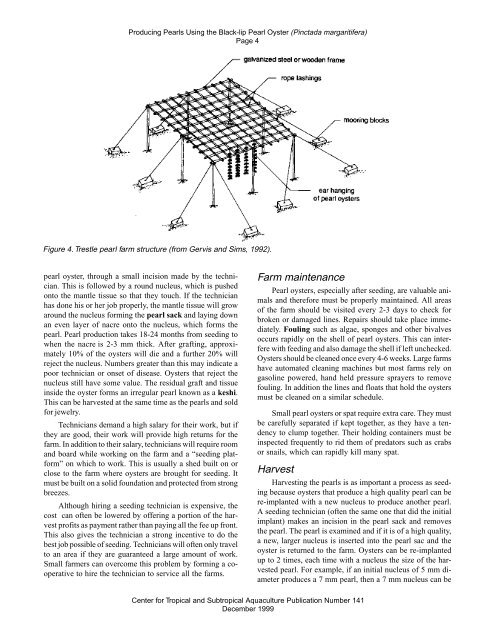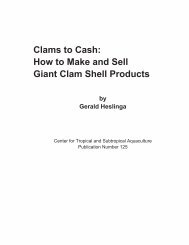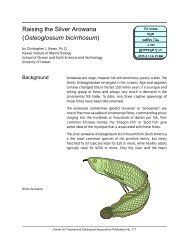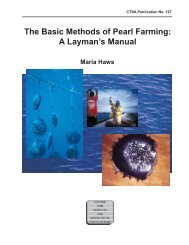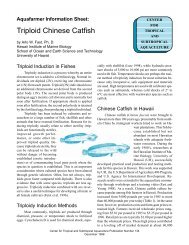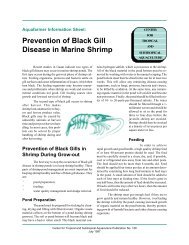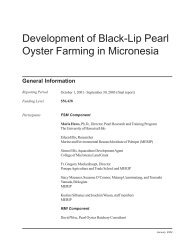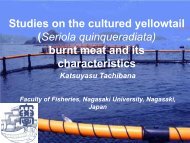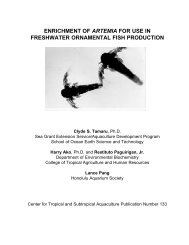Producing Pearls Using the Black-lip Pearl Oyster - CTSA
Producing Pearls Using the Black-lip Pearl Oyster - CTSA
Producing Pearls Using the Black-lip Pearl Oyster - CTSA
Create successful ePaper yourself
Turn your PDF publications into a flip-book with our unique Google optimized e-Paper software.
<strong>Producing</strong> <strong><strong>Pearl</strong>s</strong> <strong>Using</strong> <strong>the</strong> <strong>Black</strong>-<strong>lip</strong> <strong>Pearl</strong> <strong>Oyster</strong> (Pinctada margaritifera)Page 4Figure 4. Trestle pearl farm structure (from Gervis and Sims, 1992).pearl oyster, through a small incision made by <strong>the</strong> technician.This is followed by a round nucleus, which is pushedonto <strong>the</strong> mantle tissue so that <strong>the</strong>y touch. If <strong>the</strong> technicianhas done his or her job properly, <strong>the</strong> mantle tissue will growaround <strong>the</strong> nucleus forming <strong>the</strong> pearl sack and laying downan even layer of nacre onto <strong>the</strong> nucleus, which forms <strong>the</strong>pearl. <strong>Pearl</strong> production takes 18-24 months from seeding towhen <strong>the</strong> nacre is 2-3 mm thick. After grafting, approximately10% of <strong>the</strong> oysters will die and a fur<strong>the</strong>r 20% willreject <strong>the</strong> nucleus. Numbers greater than this may indicate apoor technician or onset of disease. <strong>Oyster</strong>s that reject <strong>the</strong>nucleus still have some value. The residual graft and tissueinside <strong>the</strong> oyster forms an irregular pearl known as a keshi.This can be harvested at <strong>the</strong> same time as <strong>the</strong> pearls and soldfor jewelry.Technicians demand a high salary for <strong>the</strong>ir work, but if<strong>the</strong>y are good, <strong>the</strong>ir work will provide high returns for <strong>the</strong>farm. In addition to <strong>the</strong>ir salary, technicians will require roomand board while working on <strong>the</strong> farm and a “seeding platform”on which to work. This is usually a shed built on orclose to <strong>the</strong> farm where oysters are brought for seeding. Itmust be built on a solid foundation and protected from strongbreezes.Although hiring a seeding technician is expensive, <strong>the</strong>cost can often be lowered by offering a portion of <strong>the</strong> harvestprofits as payment ra<strong>the</strong>r than paying all <strong>the</strong> fee up front.This also gives <strong>the</strong> technician a strong incentive to do <strong>the</strong>best job possible of seeding. Technicians will often only travelto an area if <strong>the</strong>y are guaranteed a large amount of work.Small farmers can overcome this problem by forming a cooperativeto hire <strong>the</strong> technician to service all <strong>the</strong> farms.Farm maintenance<strong>Pearl</strong> oysters, especially after seeding, are valuable animalsand <strong>the</strong>refore must be properly maintained. All areasof <strong>the</strong> farm should be visited every 2-3 days to check forbroken or damaged lines. Repairs should take place immediately.Fouling such as algae, sponges and o<strong>the</strong>r bivalvesoccurs rapidly on <strong>the</strong> shell of pearl oysters. This can interferewith feeding and also damage <strong>the</strong> shell if left unchecked.<strong>Oyster</strong>s should be cleaned once every 4-6 weeks. Large farmshave automated cleaning machines but most farms rely ongasoline powered, hand held pressure sprayers to removefouling. In addition <strong>the</strong> lines and floats that hold <strong>the</strong> oystersmust be cleaned on a similar schedule.Small pearl oysters or spat require extra care. They mustbe carefully separated if kept toge<strong>the</strong>r, as <strong>the</strong>y have a tendencyto clump toge<strong>the</strong>r. Their holding containers must beinspected frequently to rid <strong>the</strong>m of predators such as crabsor snails, which can rapidly kill many spat.HarvestHarvesting <strong>the</strong> pearls is as important a process as seedingbecause oysters that produce a high quality pearl can bere-implanted with a new nucleus to produce ano<strong>the</strong>r pearl.A seeding technician (often <strong>the</strong> same one that did <strong>the</strong> initialimplant) makes an incision in <strong>the</strong> pearl sack and removes<strong>the</strong> pearl. The pearl is examined and if it is of a high quality,a new, larger nucleus is inserted into <strong>the</strong> pearl sac and <strong>the</strong>oyster is returned to <strong>the</strong> farm. <strong>Oyster</strong>s can be re-implantedup to 2 times, each time with a nucleus <strong>the</strong> size of <strong>the</strong> harvestedpearl. For example, if an initial nucleus of 5 mm diameterproduces a 7 mm pearl, <strong>the</strong>n a 7 mm nucleus can beCenter for Tropical and Subtropical Aquaculture Publication Number 141December 1999


